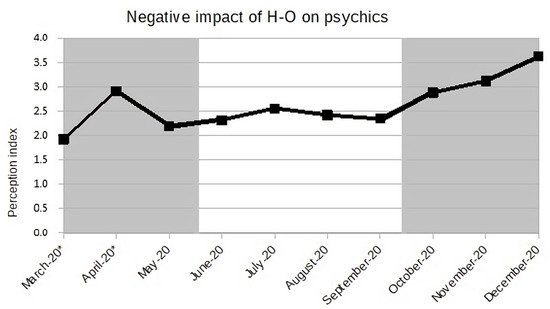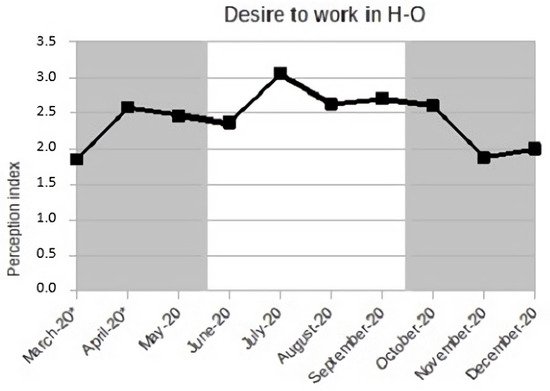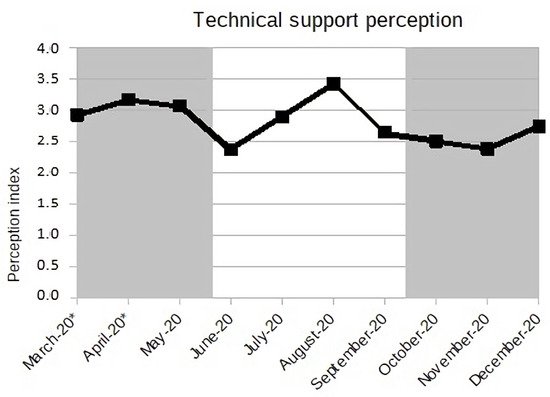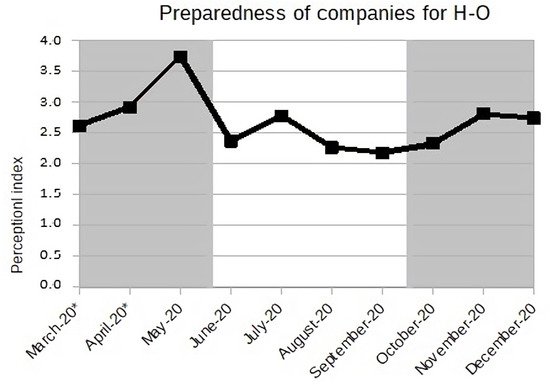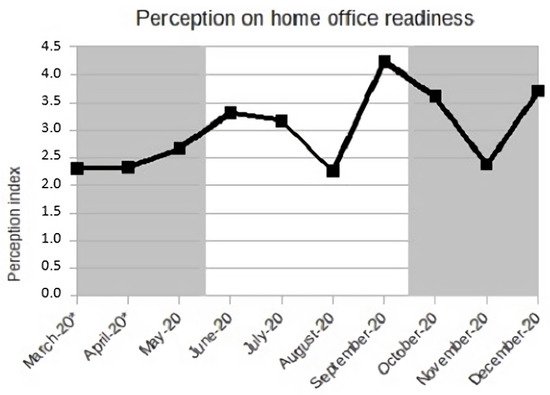This study investigates the effect of COVID-19 lockdowns and non-lockdown phases on managers and employees in the Czech Republic in the year 2020. The Czech Republic came through the first COVID-19 wave in spring 2020 with low case numbers, but became one of the countries with the highest case incidences in the second autumn wave in Europe. The study focused on examining the differences of perceptions on digital readiness of the company, working style, and mental health variables of working personnel in lockdown and non-lockdown phases. Data was obtained by an online survey conducted monthly from March-2020 to December-2020 with the same questions each month. Collected data consisted of respondents’ basic information on the actual situation, on perceptions on company and technology and on perceptions of the own mental state in the given month, retrieved from a pool of employees and managers from the Czech Republic machine and equipment manufacturers’ industry. Statistical analysis was conducted with the Kruskal-Wallis test for ordinal variables to check for significant differences in perceptions during 2020. Results show that managers in general and telecommuting-experienced workers in particular are better able to adapt to forced home office, while telecommuting-inexperienced employees struggle to adapt positively even with increasing company support and with an increasing digital team communication.
1. Introduction
In 2020, the World Health Organization (WHO) announced the COVID-19 epidemic to be a pandemic
[1][2]. Several countries all over the world began to take countermeasures by applying e.g., lockdowns
[3]. European countries took measures against the pandemic by restricting private, social, and work life. Social and work life was locked down to prevent a further spreading of the virus
[4]. Following Italy, which took the lead in absolute numbers of infected people in this first COVID-19-wave in Europe, several other countries applied similar measures
[5]. Full or partial lockdowns (also referred to as shutdowns) were imposed
[6]. Imposed government rules to keep distance among employees and to keep distance between employees and company externals as well as the immediate decrease in demand from customers forced companies and governments to find a solution to the situation
[7]. In order to prevent employees from meeting each other directly, employees were sent home for telework from home (also referred to as home office), belonging to the governments’ stay-at-home orders for their population
[8]. The lockdowns had economy-wide impacts and affected employees and managers from small, middle-sized, and big companies at the same time by sending them on forced home office.
Sending employees into a home office framework exposed these employees to a framework similar as it is known from previously-studied telecommuting
[9], where workers did not have a fixed workplace
[10]. Companies and company management had to take measures in order to adjust their business processes according to new requirements. Companies that were used to work only in a daily office framework missed IT-infrastructure
[11] and were organizationally not prepared for a widespread home office working
[12]. Employees that were not used to working at home were now forced to do so. Without planning and mostly without training, employees were sent on home office without knowledge of a home office infrastructure
[13]. Also, managers were forced into home offices, having to care for a whole team being sent to sudden home office without preparation
[14]. Additionally, schools closed, sending children home, where their parents worked in home offices
[15].
With the movement to a sudden home office framework and the imposure of country-wide lockdowns, workers had to adapt to the new living and working style style
[16]. People showed significantly-increased tendencies towards depression, psychical stress, and anxiety
[17]. The policy of social distancing did not allow for private physical contact but allowed only for digital ways to maintain relationships. Additionally, workers had to switch to a digital environment for working purposes. This also included the mere digital contact with further organization and team members
[14]. Workers transferring from a daily home office job were exposed to changes in an even higher level than workers coming from a telecommuting framework. However, depending on the country of operation, different rulesets were available to choose which way telework, home office, and further instruments could be applied
[18]. The German instrument of “Kurzarbeit” (English translation: Short work) allowed companies to send their employees on paid vacation to a certain extent while the German state took over part of the salary
[19]. Similar instruments were applied in other European countries
[20]. Also, part of the Czech industry worked in a framework of short work, while the major concern was with the disruption of supply chains and coordination issues with international colleagues not being present and international production halls being closed
[21].
The Czech Republic was able to come through the first pandemic wave in spring 2020 with a low case incidence rate and with a lockdown. Between May 2020 and October 2020, the Czech Republic went into a non-lockdown phase. In autumn 2020, it became the European country with the highest case incidence rates and a second lockdown began in October-2020. Social contacts had to be reduced
[22]. Similar telecommuting frameworks in work are known to have ambiguous impacts on different employees. While one part of employees sees telecommuting as beneficial and conducive to freedom, the other part claims higher organizational pressure and a feeling of loneliness and missing social interaction
[23]. It is a question how the sudden transition into home office changed the working style and the perception of aspects of home office over time through lockdown and non-lockdown phases in 2020. Hence, the study in this paper is conducted to have a look on whether patterns of perceptions during lockdown are significantly different from those in non-lockdown phases and whether there is a difference in managers and employees. The reason to look on the Czech Republic is due to the fact that it went through two lockdown phases in the year 2020. Thus, the research objective in general is to analyse the impact of forced home office during the year 2020 in lockdown and non-lockdown phases on managers and employees. The existing literature suggests that, although already mentioned in the 1980, research did not focus on managers on telecommuting but rather on how managers should work with telecommuting employees
[24] similar to the COVID-19 pandemic, where mental health issues were usually discussed for employees, not for managers
[25]. Hence, it is the purpose of this paper to contribute to the existing research gap in this field.
2. Discussion
This research was conducted with the objective to analyse the impacts of the COVID-19 forced home office frameworks on managers and employees in the machine and equipment manufacturer business. For this, the differences between people coming from a telecommuting framework were assumed to show a better adaptability to the COVID-19 circumstances in lockdown and non-lockdown phases. The finding of the analysis shows an overall inclination towards this assumption. However, managers and employees show a difference in their self-perceptions, where managers show a lower score of negative impact on psyche. Managers perceive themselves to have lower negative impacts on psyche. Managers that are assumed not to have telecommuted before seem to be able to adapt a more positive adaptive behaviour. An explanation for this might be the learned discipline and self-organisation behaviour that managers need in their daily office work.
Support from the company, from managers, and from the team in general is assumed to enhance positive adaptive behaviour of the individual. However, neither an increased perception of the company preparedness for digitalization, nor an increased perception of the company readiness for home office by the employee or manager, seemed to confirm this suggestion. While there was no significant difference found between employees and managers concerning these characteristics, improved ratings do not show any positive effect on the characteristic of negative impact on psyche. Interestingly, companies are not able to significantly enhance the situation of their managers and employees. Also, an increasing rating of contact with the team does not lead to significant betterment of the situation. An explanation may be, that companies are not able to compensate the negative impacts of forced home office through their support, without significant differences between lockdown and non-lockdown phases. Thus, the lockdown seems not to be the primary source for negative adaptive behaviour, but the forced home-office instead is of much higher importance.
From the literature review, it might be assumed that managers and employees differ in their perceptions towards company preparedness for digitalization and in their perception towards company readiness for home office. This was confirmed by the analysis. Managers had a significantly higher perception of the preparedness and readiness than employees. It can only be suggested that the effect leading to a self-biased perception is high with managers. Managers have been introducing and implementing measures to enhance preparedness and readiness in the company themselves and may be convinced of the effectiveness of the latter. Employees, however, show in their perception that they do not fully agree with the view of the managers. A further possible explanation might be the significant increase of working hours that employees expect during lockdown times.
Even though the monitored companies are used to telecommuting, these companies seem to have been struggling with the framework for forced home office until the end of 2020. Previous studies came to the conclusion that women had a higher inclination towards negative mental impacts
[26][27][28]. In this study, there could not be found evidence that women would be worse off mentally. However, survey data did neither support gender nor the number of children in the household to show any significance as independent variables. It seems that the forced home-office circumstances puts a higher psychical burden on employees than on managers expressed by the desire to work less on home office. Digital company and colleague support is not able to compensate the negative impacts of forced home office. Support of this is given as telecommuting-experienced employees and managers also show significantly differing perceptions in lockdown and non-lockdown phases.
Referring to the research objective to analyse the impact of forced home office during the year 2020 in lockdown and non-lockdown phases on managers and employees, it may be said that telecommuting-experienced employees and managers show better positive adaptive behaviour. This contributes to the current theory as managers seem to have a higher ability to adapt positively than their employees.Further, managers see the support from the company in the digital framework and for home office work much more positively than employees. Even though, managers are mostly not working in telecommuting frameworks
[14][29], their better adaptability to forced home office work shows off in the self-perception scores. Although managers and employees are using digital communication for their daily work, it seems that employees seem to lose grip while managers seem content with the situation. This may have led to a certain form of myopia and self-bias, as managers seem to judge their situation based on whether the company management has evolved. Managers are not dealing with the situation as an isolated issue, but they evaluate it on the basis of the company’s commitment for support. Hence, understanding the impacts of forced home office and further frameworks is a challenge for managers. Even though employees do also rate company support as better over time, this is not enough to make up for the negative impacts these employees experience.
Graphically, the results of the survey concerning the mean values for the dependent characteristics may be found in
Appendix A.
Figure A1,
Figure A2,
Figure A3,
Figure A4,
Figure A5 and
Figure A6 show the development of mean values in the course of the year 2020 for the characteristics company readiness, company preparedness for home office, technical support, desire to work, missing social interaction, and the impact on psyche arising from lockdown and non-lockdown phases.
Appendix A
Figure A1. Negative impact of home office on psychics (own processing).
Figure A2. Perception of missing social interaction (own processing).
Figure A3. Desire to work in home office (H-O) (own processing).
Figure A4. Perception of company’s technical support level (own processing).
Figure A5. Perception of company’s preparedness for home office (H-O) (own processing).
Figure A6. Perception of home office readiness (own processing).

